Kubler and Koblet
 Fri, August 24, 2007
Fri, August 24, 2007 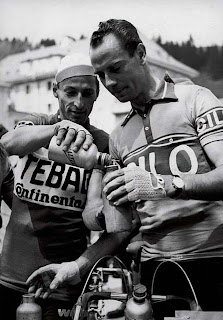 Ferdi Kubler (Left.) and Hugo Koblet, two more cycling heroes from my youth.
Ferdi Kubler (Left.) and Hugo Koblet, two more cycling heroes from my youth.
It just doesn’t seem right to mention one without the other. Maybe because they were both from Zurich, Switzerland, maybe because they both have last names that have six letters and begin with the letter “K.” For whatever reason, to write about them separately somehow seems like breaking up a set.
In 1950 Hugo Koblet became the first non-Italian to win the Giro d’Italia; that same year Ferdinand Kubler was the first Swiss to win the Tour de France. The following year, 1951 Koblet would win the Tour de France, and Kubler the World Championship Road Race.
They were both true all round riders; at home on the track riding a pursuit race or a six-day event. They could ride alone against the clock in a time trial, and both were excellent climbers. Kubler could also out-sprint the best of his day. 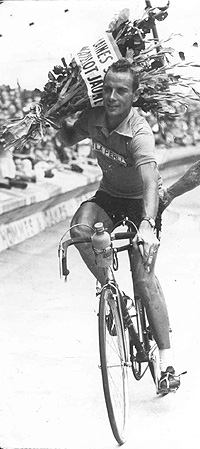 Physically you could not find two people that were more unalike. Koblet (Pictured left.) had the good looks of a movie star, and would often sit up in the last kilometer of a race, and comb his hair. He would sometimes do this on a hard climb, as a psychological ploy to demoralize the other riders. He earned the nickname of "Pédaleur de Charme" for his beautiful smooth pedaling style.
Physically you could not find two people that were more unalike. Koblet (Pictured left.) had the good looks of a movie star, and would often sit up in the last kilometer of a race, and comb his hair. He would sometimes do this on a hard climb, as a psychological ploy to demoralize the other riders. He earned the nickname of "Pédaleur de Charme" for his beautiful smooth pedaling style.
Kubler on the other hand had rugged, hollow cheeked features, and a huge nose. And, if Hugo Koblet looked pretty on a bike, Ferdi Kubler often looked like some demonic hunch-back when pictured in full flight.
Kubler (Below.) had more wins throughout his career, but Koblet often won in great style; for example on his way to his 1951 Tour win. It was Stage 11, the stage before the Pyrenees and the Alps. On such a stage, everyone would typically take things easy, saving themselves for the days that followed.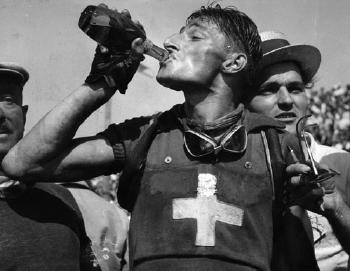 Koblet probably knew this was the way everyone would think, so he did the opposite. Some thirty or more kilometers from the start, in sweltering heat, he attacked on a small climb, followed only by French rider Louis Deprez.
Koblet probably knew this was the way everyone would think, so he did the opposite. Some thirty or more kilometers from the start, in sweltering heat, he attacked on a small climb, followed only by French rider Louis Deprez. 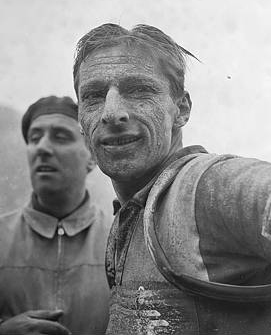
The other contenders that year all chose to ignore this seemingly irrational move. After a few kilometers Deprez must have felt the same way and he dropped back to the peleton, leaving the Swiss rider on his own.
However, when Koblet’s lead increased to four minutes with seventy kilometers to go, the peloton woke up and began to chase back in earnest. Now, all the big guns were at the front; Bartali, Bobet, Coppi, Geminiani, Magni, Ockers, Robic, adding their weight to the chase but still could not make an impression on Koblet’s lead.
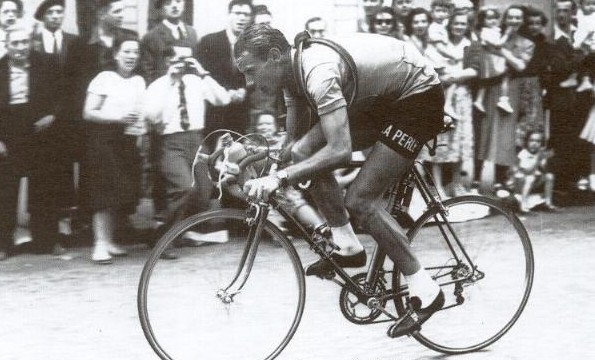
After riding one hundred and forty kilometers alone, (87 miles.) Hugo Koblet (Above.) reached the finish in the town of Agen. His face showed no stress at holding off the entire peloton. Koblet crossed the finishing line, then calmly dismounted and started a stopwatch to see what advantage he has gained over the rest of the field.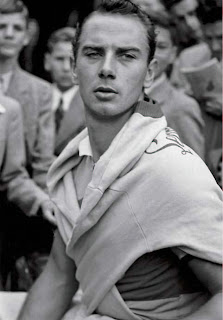 Two minutes and thirty-five seconds later the rest of the peloton crossed the line exhausted and astonished by Koblet’s great escape. With the best riders of that era, working together, and chasing hard, they had only managed to pull back less than a minute and a half on the flying Swiss rider.
Two minutes and thirty-five seconds later the rest of the peloton crossed the line exhausted and astonished by Koblet’s great escape. With the best riders of that era, working together, and chasing hard, they had only managed to pull back less than a minute and a half on the flying Swiss rider.
Koblet gained the utmost respect of the World’s leading riders and French Press that day. Writing for the Parisien Libere, Jacques Grello coined the phrase "Pédaleur de Charme." A name that will stick with Koblet for all time.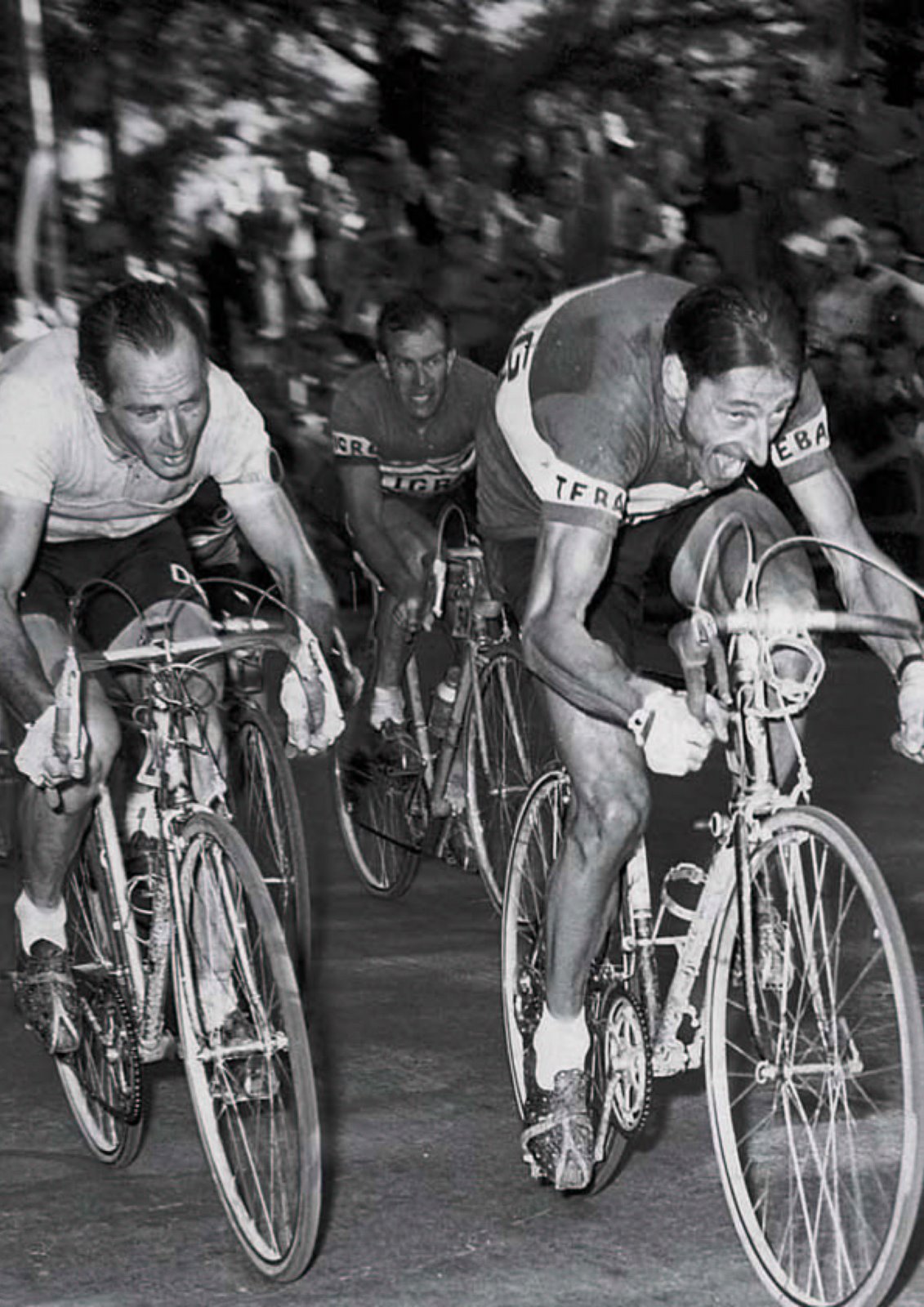 Kubler and Koblet (Left.) always spoke highly of each other, and showed a mutual respect. They sometimes rode on the same team, most times they were rivals. However, they never declared it.
Kubler and Koblet (Left.) always spoke highly of each other, and showed a mutual respect. They sometimes rode on the same team, most times they were rivals. However, they never declared it.
Hugo Koblet died tragically in a car crash in 1964, aged 39.
Ferdinand Kubler, a fitness fanatic throughout his life, is still living, and at aged 88 years is the oldest living Tour de France winner.
 Dave Moulton | Comments Off |
Dave Moulton | Comments Off | 

















Reader Comments (6)
Or maybe I'm just an ignorant American who doesn't know who to google.
It was a time when the bikes didn't change much, but the best riders left a legacy of class.
I tried to emulate them, to visualize riding like them. It was a lot about form: to turn your hat around at the base of a climb; to grasp next to the stem while climbing; to spin steady but smoothly.
I didn't get as far as grooming myself on climbs. But then, who today can get away with that?
I'm waiting for a book on your cycling memories...
There are two highly recommendable books on Koblet and Kübler. Both are in German, but the pictures are worth seeing at any rate. Rare, sometimes never before published material:
Author: Born, Hanspeter
Title: Hugo Koblet - Pedaleur de Charme
Author: Born, Hanspeter
Title: Ferdy Kübler
Markus (Switzerland)
Hi Dave. I have here a picture in a French magazine of the bike of Hugo Koblet,taken in 1951. the bike says CHAMPION DU MONDE [Champion of the World] on the down tube,the caption says 'Velo "Automoto".' It doen't have any rear gear changer in sight,only a chainwheel lever changer on the seat tube.
What do you think this is,and did it have only front gears? I hardly think it was an automatic changer. Your thoughts would be appreciated. REGARDS, Ian Ash